A 6-day trip through Beijing, Tianjin and Hebei province

Transit passengers from 54 countries including the US, Canada and all members of the EU can spend up to 144 hours in Beijing without a visa. This visa-free policy allow foreigners from these 54 countries with visas and plane tickets to a third country to transit through Beijing for a visa-free stay of up to 144 hours. The below provides a suggested itinerary for a 6-day trip.
Day One: Royal City
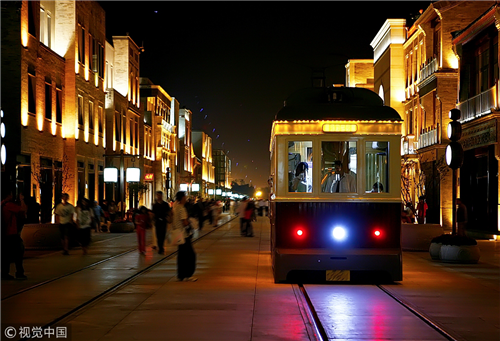
Dang Dang Che, a traditional Chinese tram was running on Qianmen Street, bringing the past back to life [Photo/VCG]
Beijing is a famous historical and cultural city with a history spanning more than 3,000 years — over 860 years of which it has served as capital.
In the morning, you can visit Qianmen Street. As a well-known commercial street in Beijing, Qianmen Street has over 570 years of history and has always been the prosperous and bustling area in Beijing. It is composed of buildings whose styles resemble the late Qing Dynasty.
As a must-try snack street for tourists, it has accumulated many long-standing stores, such as Qunjude Peking Duck, Duyichu Shaomai (a steamed dim sum made of glutinous rice, pork mince, Chinese mushroom and onion), Yitiaolong Restaurant and Kaifeng Diyilou Soup Dumpling.
In addition, if you visit the street now, you will see the traditional Chinese tram named Dang Dang Che, which runs on this street and visitors can get on it to have an experience of the old Beijingers.
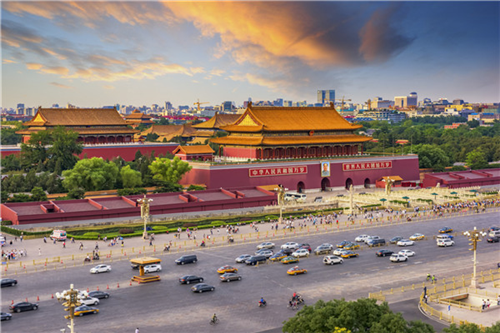
The Tiananmen Square, where grand ceremonies are held every year, witnessed the vicissitudes of the modern Chinese history [Photo/VCG]
The Tiananmen Square is at the center of Beijing city. It's the largest square in the world, encompassing an area of 14 hectares.
The Five-Star Red Flag flutters high above the mid-point of the square's north side. Everyday, at dawn and dusk, the guards march in unison to the foot of the flagstaff to hoist or lower the national flag, which is saluted by on-lookers.
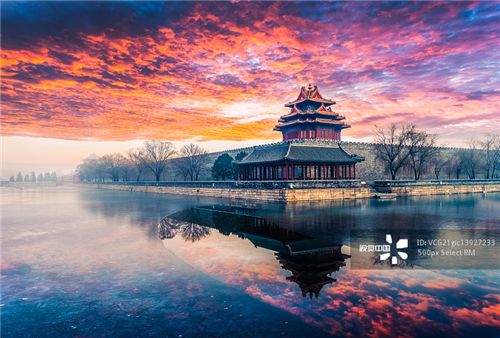
One corner of the Forbidden City was bathed in the glow of sunset [Photo/VCG]
In the afternoon, you can visit the Forbidden City (known now as Palace Museum). Covering an area of 1.12 square kilometers, the Forbidden City, built in 1420, was home to 24 emperors of the Ming (1368-1644) and Qing (1644-1911) dynasties.
The Forbidden City was commissioned to build by the third emperor Zhu Di of the Ming Dynasty. The palace was built between 1406 and 1420, but was burnt down, rebuilt, sacked and renovated countless times, so most of the architecture visitors can see today dates from the 1700's and onward.
The Forbidden City was the seat of Imperial power for 500 years, and is now a major tourist attraction in China.
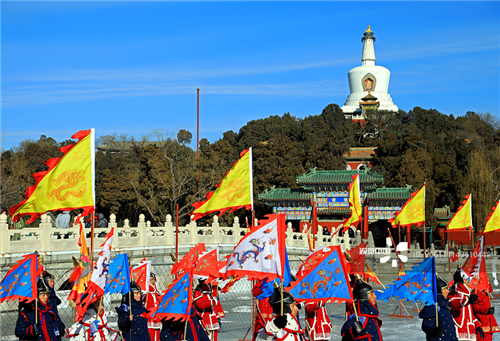
Play the unique Beijing style ice sledding, drink the secret Chinese tea, see the 500 years old White Pagoda——one of the oldest and largest imperial gardens in China will keep you busy with countless fun [Photo/VCG]
Beihai Park is one of the oldest and best-preserved imperial gardens. It is located in the center of Beijing, and is very close to the famous Forbidden City. Beihai Park boasts a history dating back more than a millennium and existed throughout the dynasties of Liao, Jin, Yuan, Ming and Qing.
Beihai Park covers an area of more than 68 hectares, more than half of which is covered by its lake. It is considered an ancient Chinese art form, with different features, such as artificial hills, bridges, pavilions, halls, temples and lakes. It provides visitors with a unique insight into Chinese culture and legend close to the heart of Beijing.
Walking out of the South Gate of Beihai Park, you will see the Huguosi Xiaochi Restaurant. At mealtime, you can have a short break while enjoying a great variety of yummy and cheap Beijing snacks, like the traditional miancha, fried butter cake, glutinous rice ball, lvdagun (rolling soybean cake) and pease pudding.
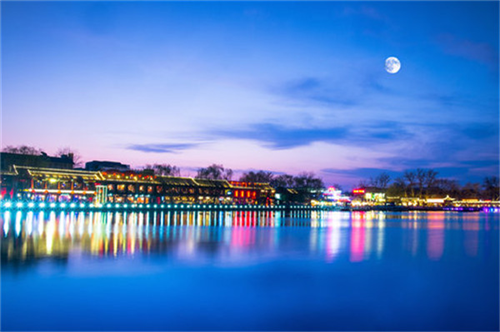
Shichahai is an ideal hangout on your Beijing night tour no matter you seek for fun or try to immerse yourself into an authentic Beijing atmosphere [Photo/VCG]
At night, Shichahai is a place that you won't want to miss. Shichahai Bar Street is an epitome of Beijing culture. Bars on both sides of Shichahai Bar Street are rebuilt from dwellings, with arm's reach to traditional siheyuans (courtyard houses).
Permeated with civil culture, the fashionable bar street is embraced by quaint courtyards, embodying unique Beijing characteristics. In the sunset, you can take a leisurely stroll along the river and appreciate the classic architecture and peaceful environment, enjoying a unique pleasure.
Day Two: the Great Wall
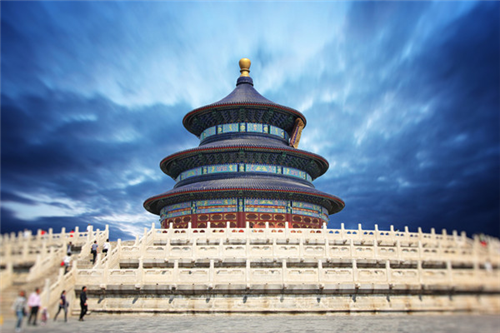
In the Temple of Heaven, the theories of yin and yang and the five elements in the Book of Changes were used on the location selection, planning, construction, as well as the sacrificial rites, which successfully expressed the ancient Chinese’s understanding of the relations between heaven and men [Photo/VCG]
One the second day, I suggest you take this opportunity to see the place where Chinese emperors worshiped Heaven and prayed for bumper crops. The Temple of Heaven was built in 1420, and then expanded and reconstructed during the Ming and Qing dynasties.
As a masterpiece of the Ming and Qing architectural art and a precious example of China's ancient architecture, the Temple of Heaven is the largest architectural group for Heaven-worshiping in the world and mirrors its unique Chinese philosophy.
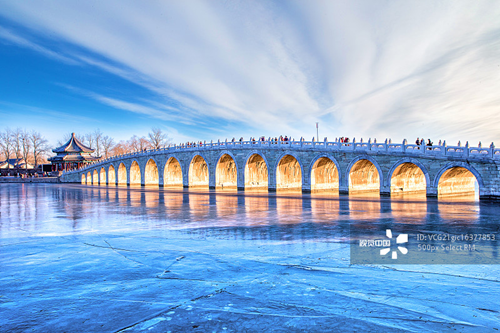
Originally built for guests who came to the Summer Palace for an audience with Empress Dowager Cixi, these courtyards are enveloped in unworldly beauty and peaceful serenity. [Photo/VCG]
With its beautiful scenery and quiet landscape, the Summer Palace is an ideal place to escape from the summer heat.
The natural landscape of hills and open water is combined with artificial features such as pavilions, halls, palaces, temples and bridges to form a harmonious ensemble of outstanding aesthetic value.
It is full of the magnificent momentum of Chinese imperial gardens while also full of natural interest, which highly embodies the garden's design principle of "although being man-made, it seems like a natural gift".
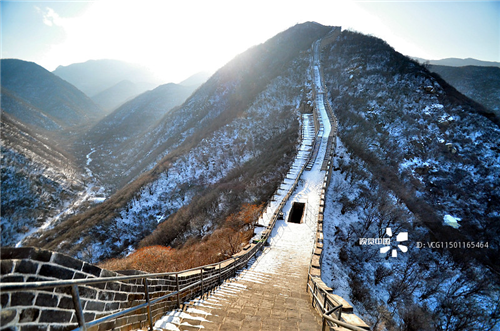
The Badaling Great Wall dances like a dragon among the rolling mountains. Located in Yanqing District, northwest Beijing, Badaling Great Wall is a world-famous tourist destination for its magnificent scenery, excellent facilities as well as rich culture and history. [Photo/VCG]
The lofty ridges and towering mountains, the deep trenches and high ramparts, all contribute to the strength of the Badaling Great Wall.
When climbing the great wall, you can see the broken wall crawling on the ridges with old beacon towers guarding there. Some stone steps have become piles of stones due to disrepair. The remnant wall, with its broken body, expresses a beauty of majesty.
Day Three: the Journey of Culture in Tianjin
On the third day, you can travel to the east, and come to Tianjin, a metropolis in northern China.
The "Five Avenues" is a famous tourist attraction in Tianjin, it is called a museum of architectures of different European countries, including Italy, Germany and Spain, etc.
Parallel streets from east to west are named after five cities of southwest China, namely Chongqing, Changde, Dali, Munan, and Machang. And that's why the local Tianjin people call the area "The Five Avenues".
It is an obligatory destination for those interested in photography, with exotic architectures and trees that line the avenues in summer. The red plastic track of Minyuan Stadium lightens up the whole district.
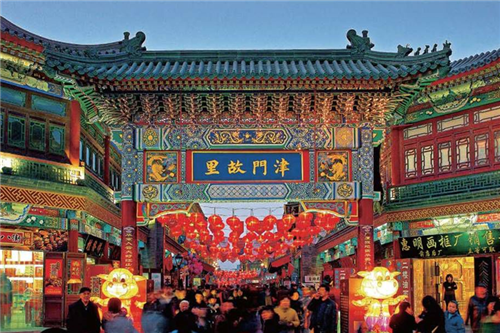
The Tianjin Ancient Culture Street retains antique features and its main street still keeps its ancient architectural style from 600 years ago. [Photo/VCG]
Every historical city has at least one historical block offering a glimpse into its local past. In Tianjin such a street is called Guwenhua Jie.
It is a commercial pedestrian street mimicking the ancient ones with classical architectures housing shops of specialties such as Clay Figure Zhang, Yang Liu Qing Paintings, Goubuli Steamed Dumplings and Erduoyan (the Ear-hole Lane) Fried Glutinous Cakes... It is a paradise of folk culture and delicacies.
On the street you can appreciate the life-like clay figurines, have a closer look at the Yang Liu Qing Paintings, and sample the reputed Goubuli Steamed Dumplings as well as the most famous glutinous cakes in Tianjin, the Erduoyan (the Ear-hole Lane) Fried Glutinous Cakes. If you are still not stuffed, treat yourself to an "Eighteen Streets" Fried Dough Twist and you have tasted all the "Three Top Tianjin Delicacies".
Haihe River is the mother river of Tianjin, attracts many exercisers with fabulous riverside scenery. The section between Jiefang Bridge and Yongle Bridge, which is perfect on length and located with series famous attractions like Jinwan Square, Austria-Hungary Consulate, Temple of Great Compassion and Tianjin Eye, is the third jogging route recommended.
Different from the other two route, this one is perfect for night jogging to enjoy the peaceful night breeze and be in company with romantic night scene of European architectures, as well as the soothing music from earphone.
After a day's trip, you can go to appreciate the only Italian concession in the world, the Italian Style Street. It features more than 200 well preserved European architectures, such as the Marco Polo Square, the Jai Alai Club and former residences of scores of historical figures. Many distinguished personages once set foot here, including Liang Qichao and Yuan Shikai.
Day Four: Shanhai Pass
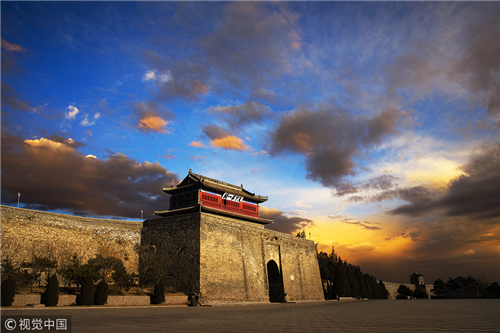
Throughout Chinese history, the pass served as a frontline defense against ethnic groups from Manchuria, including the Khitan, Jurchen and the Manchus. [Photo/VCG]
On the fifth day, you can go to appreciate the starting point of the Great Wall of China---the Shanhai Pass. It is located in Shanhaiguan District, Qinhuangdao, Hebei province.
The words "First Pass Under Heaven" are engraved above one of the gates, and so the site is also known by that name. It is a popular tourist destination given its situation at the eastern end of the main line of the Ming Dynasty Great Wall. The location where the wall meets the Bohai Sea is nicknamed "Old Dragon's Head"..
Throughout Chinese history, the pass served as a frontline defense against ethnic groups from Manchuria, including the Khitan, Jurchen and the Manchus.
Beidai River is not far from Shanhai Pass, it is located in the southwest of Qinhuangdao City.
Beidai River is the largest recovering center of China. In 1982, it was listed as the National Historic Sites and Scenic Spot. In 1999, It attained "the Outstanding Tour City" as well as "the Gardens City".
The seawater here is a natural bathing place with limpid water and well-situated salinity. Chairman Mao once said: "The sunlight, sea and air of Beidai River are the most attractive."
Day Five: Chengde Imperial Summer Resort
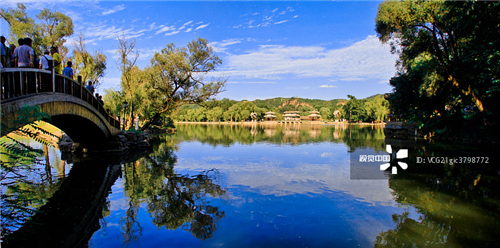
With the quintessence of natural mountain and water landscapes and a nice blend of views unique to southern and northern China, Chengde Mountain Resort is hallmarked with understated and elegant rustic charm, making itself China’s largest ancient royal palace by area in existence. [Photo/VCG]
Chengde Summer Resort is in the north of Chengde downtown, which is famed for its reputation as the private resort for Chinese emperors during summer.
Built in 1703, the resort coasted about 90 years to construct, covering 564 hectares. The resort is divided into two sections: the palace area and the scenic area, the latter one containing Lake Zone, Plain Zone and Mountain Zone.
As far as the palace is concerned, it is usually viewed as the picture of majesty and splendor. However, you will have a different view if you come to visit the palace in the Chengde Summer Resort. They are more likely to the residential houses in North China with black bricks and gray tiles, rock steps covering with old pine trees, more peaceful and elegant.
The Great Wall is a must-go for most visitors. Besides the Badaling Great Wall and Mutianyu Great Wall, there is such a section of the Great Wall can also brings you perfect hiking experience.
The Jinshanling Great Wall is the best-preserved section of the Ming Great Wall. Straddling the demarcation between Hebei province and Beijing, the Jinshanling Great Wall is rich in architectural history and natural scenery.
At an altitude of 700 meters, you can appreciate beautiful landscape from the top of the Great Wall, mountains gathering like static waves, Miyun Reservoir shining under sunshine and Simatai Reservoir reflecting blue sky. It's the best option for photographers.
Day Six: Ancient Town
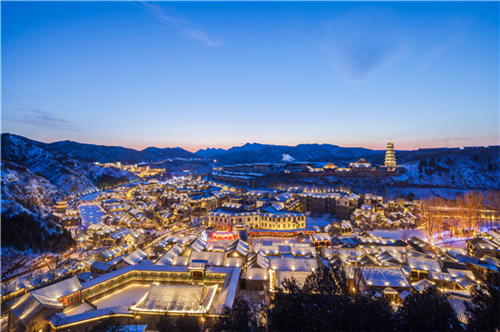
Gubei Water Town is a rare natural old town with a combination of mountains, water and ancient villages. [Photo/VCG]
On the last day, you can come back to Beijing, and take a rest in this ancient with a history of one thousand years---Gubei Water Town
This town possesses an old-fashioned simplicity and elegance. Row upon row of houses, old quartzite streets and long Hutongs characterize the style and features of the old town. River channels are scattered between streets; houses near the river are bathed in sunlight.
When night falls, Gubei Water Town presents a tranquil and cozy atmosphere. Some spots of the attraction are open to the public, such as the Blocks of the Republic of China, the Old Camp Site, the Water Streets Region, the Wolongbao Folk Culture Region, the Old Village at Tang River Region, and the Local Accommodation Region.
Besides sightseeing, visitors can experience unique local customs and participate in native activities. If you like Chinese wine, the Sima Liquor distillery may be a nice choice for a visit. You can smell the aroma of the wine from afar before you reach there. You can also witness the process of wine making and learn to cook dishes with vinasse (the residue that remains in the still after distillation).
In the Yongshun Dye House, red, green, yellow and blue cloths hang flapping in the breeze. Some old-style looms and spinning machines are on display. You can learn about ecological cloth printing and dyeing, and even create your own DIY work with the help of craftsmen.
MOST POPULAR
- 1 Guangdong remains top foreign investment destination in China
- 2 Boao establishes zero-carbon zone in pursuit of sustainable development
- 3 Countermeasures against foreign sanctions empowered
- 4 Things to know about Boao Forum for Asia Annual Conference 2025
- 5 China introduces new measures to facilitate travel, residency for HK, Macao, Taiwan residents on mainland







